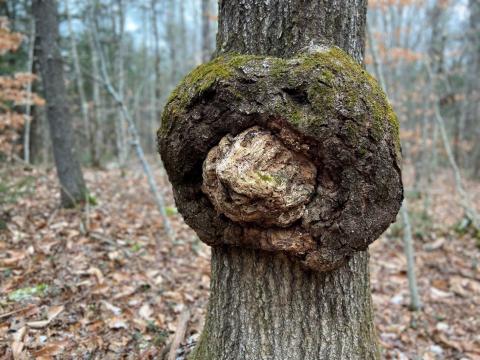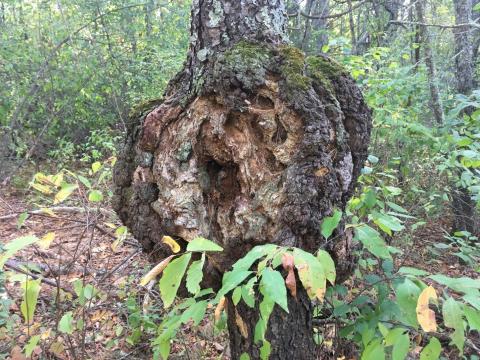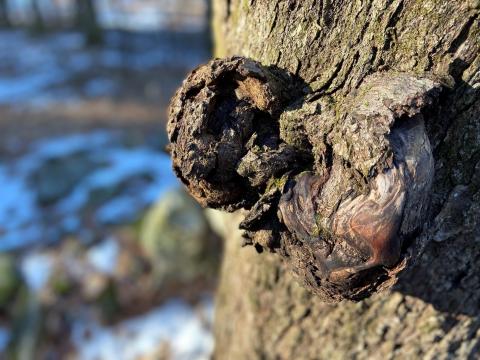The Mystery of Tree Burls

Oak burl
Whether I am in the woods, in a backyard assessing a shade tree, or measuring one of New Hampshire’s champion trees with NH Big Tree Program volunteers, burls always catch my eye—especially big ones. Burls can be found on many kinds of trees, but in southeastern New Hampshire I most often find them on oaks, maples, and cherries. Many woodworkers and woodturners are interested—understandably— in the unusual grain patterns and colors found in burlwood, but I am more interested in what causes them to grow at all.
According to Kevin Smith, Supervisory Plant Physiologist with the United States Forest Service, “a burl is the result of hyperplasia, a greatly abnormal proliferation of xylem production by the vascular cambium.”1 In other words, it is likely that some sort of infection by bacteria, viruses (yes, trees get viruses, too), fungi, or insects causes the tree to respond with highly irregular wood growth. The exact mechanism that causes burl formation is not fully understood. If it were, burls would probably be produced commercially for use by artisans.

Black cherry burl

Red maple burl
Many landowners wonder if burls hurt trees or if they should remove them. From my observations, there is little to suggest that burls cause damage to trees. On the other hand, removing a large burl will cause a large wound—like “flush cutting”—that may lead to serious decay in the tree. Unlike with proper branch pruning that protects the branch collar and branch bark ridge, trees will have trouble compartmentalizing wounds caused by removing a burl. And although woodworkers are interested in burls, they are not likely to pay much, if anything, for them. Until it is cut open, it is tough to know what the inside of a burl will look like. So, unless you are removing a tree with a burl for another reason, it is best to enjoy a burl for what it is—a bit of a mystery!

Oak burl
Have a question about your woods? Contact your Extension County Forester today!
Do you love learning about stuff like this? Subscribe to the NH Woods & Wildlife Newsletter.
A quarterly newsletter providing private woodlot owners in New Hampshire with woodlot management news, pest updates, resources, and more.
1Kevin T. Smith, Ph.D., “The Biology of Burls,” Bark, Issue 3, Fall 2012. Massachusetts Tree Wardens’ and Foresters’ Association, https://www.nrs.fs.fed.us/pubs/jrnl/2012/nrs_2012_smith-k_002.pdf
